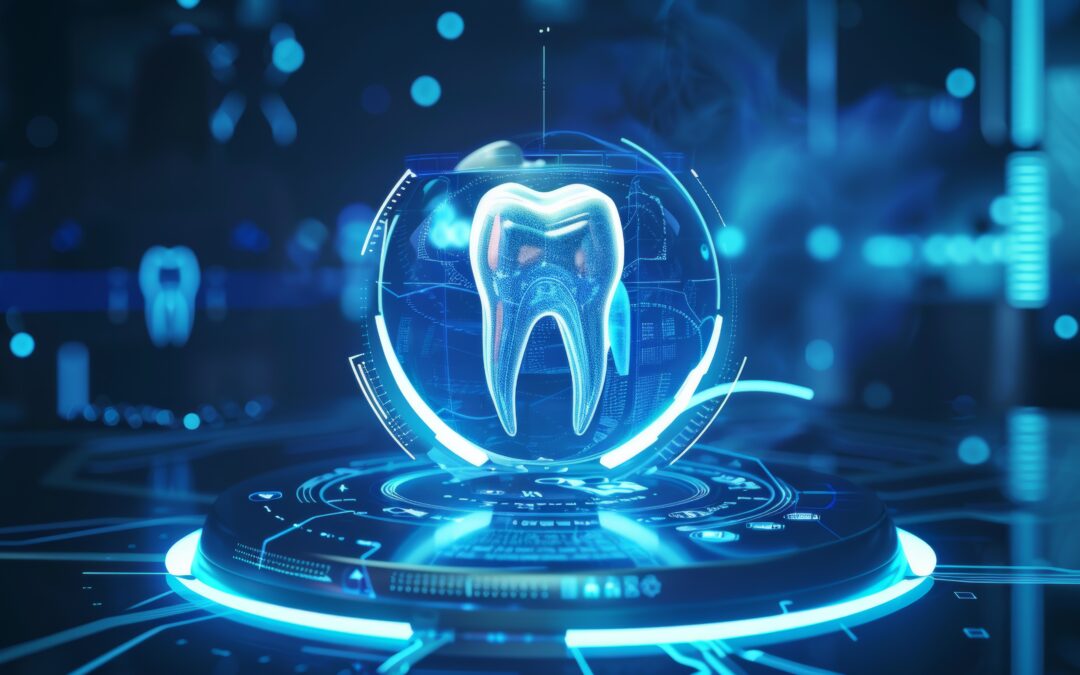


Revolutionizing Dental Practices: Embracing the Latest Tech Advances
Revolutionizing Dental Practices: Embracing the Latest Tech Advances
In today’s fast-paced world, dental practices are leveraging cutting-edge technologies to elevate patient care, enhance efficiency, and drive business growth. As advancements in artificial intelligence (AI), 3D printing, and digital workflows become increasingly accessible, dentists have unparalleled tools to meet the demands of modern dentistry. Here, we explore some of the most transformative innovations shaping the dental industry.

Artificial Intelligence in Diagnosis and Treatment Planning
AI-powered tools are redefining diagnostic accuracy and treatment strategies in dentistry. Advanced algorithms analyze X-rays, intraoral scans, and patient histories, helping dentists detect conditions like cavities, gum disease, or even oral cancer with greater precision.
AI systems not only assist with early detection but also create customized treatment plans, reducing human error and improving patient outcomes. These technologies streamline decision-making by providing real-time insights, allowing dental professionals to offer more accurate and personalized care.

3D Printing: From Crowns to Clear Aligners
Gone are the days of long waits for crowns, bridges, or orthodontic appliances. 3D printing is revolutionizing prosthodontics by enabling same-day creation of crowns, veneers, and bridges. This technology offers high accuracy, cost-efficiency, and drastically reduced turnaround times.
Orthodontic treatments have also been enhanced by 3D printing, especially in the creation of custom clear aligners. These aligners are tailored to each patient’s unique dental structure, speeding up treatment and improving the overall patient experience.

Teledentistry: Expanding Access to Care
Teledentistry is breaking down barriers in patient access, especially in underserved areas. Virtual consultations, remote monitoring, and at-home impression options are now more widely available for certain treatments.
Teledentistry enables dental practices to extend their reach and offer more flexible options for patients, all while optimizing appointment schedules. This technology is especially beneficial for multi-location practices, ensuring continuity of care without the need for in-person visits at every stage of treatment.

Digital Workflows for Streamlined Operations
These systems consolidate patient data, billing, and analytics, allowing for seamless collaboration between locations and ensuring consistent care delivery across a practice. Digital workflows also reduce administrative burdens, freeing up dental staff to focus on patient engagement and care.

Augmented Reality (AR) and Virtual Reality (VR) in Patient Education
AR and VR are transforming patient education and comfort. Virtual reality headsets are being used to help reduce dental anxiety, offering immersive relaxation experiences during procedures.
Meanwhile, augmented reality applications allow patients to visualize their treatment plans and potential outcomes, increasing understanding and fostering trust. These interactive tools empower patients with knowledge, ensuring they are more likely to follow through with their treatment plans.

Enhanced Infection Control with Smart Technologies
In the post-pandemic world, infection control remains a critical focus in dental practices. Advanced air filtration systems, touchless devices, and automated sterilization units are now essential components of dental offices.
Smart systems that monitor and maintain sterilization cycles ensure that practices adhere to the highest hygiene standards. By investing in these technologies, dental offices demonstrate their commitment to patient safety, instilling confidence in patients and the wider community.
The dental industry is undergoing a tech-driven transformation, offering unprecedented opportunities to enhance care and grow practices. By adopting these innovations, dental professionals can stay ahead of the curve while meeting the evolving needs of their patients.
As technology continues to advance, it’s essential for practices to remain agile, investing in tools that not only improve efficiency but also prioritize patient satisfaction. The future of dentistry is bright, and embracing these changes is the key to staying competitive in a rapidly evolving landscape.
Ready to Transform Your Practice?
Take the first step towards optimizing your multi-location dental practice with a free technology assessment. Discover how the right tools and strategies can help streamline your operations, enhance patient care, and position your practice for sustainable growth. Contact us today to schedule your assessment!

Top IT Strategies to Drive Business Growth in 2025
Top IT Strategies to Drive Business Growth in 2025
Leveraging innovative IT strategies is essential for businesses aiming to stay competitive and drive substantial growth. As we look ahead to 2025, companies across all sectors are faced with increasing demands for seamless digital experiences, robust security frameworks, and advanced data analytics capabilities.
Here are the top IT strategies that will be instrumental in driving business growth in the coming year.

Accelerating Digital Transformation:
Digital transformation is essential for business growth in 2025. By adopting cloud-based solutions, AI, and flexible digital infrastructures, companies can enhance productivity and swiftly adapt to market changes. Technologies like chatbots and cloud storage streamline operations and improve customer experiences. Emphasizing mobile-first strategies allows organizations to engage customers effectively across devices, driving sales and fostering brand loyalty.
In addition to enhancing operational capabilities, digital transformation fosters a culture of innovation, empowering employees to collaborate and contribute more effectively. This holistic approach improves internal efficiencies and positions companies to respond to emerging trends and customer expectations.
Why It Matters: Embracing digital transformation is critical for remaining competitive. Businesses that modernize operations can enhance their value proposition, improve customer experiences, and drive revenue growth.

Leveraging Data Analytics for Insightful Decision-Making:
Data-driven strategies are vital for anticipating customer needs and optimizing operations. Advanced analytics tools and predictive models enable businesses to analyze data, identify trends, and make informed decisions. Utilizing data visualization tools provides real-time insights that empower teams to enhance services and marketing strategies.
Moreover, leveraging data analytics promotes proactive management, allowing companies to monitor performance and customer behaviors. This approach improves customer satisfaction and resource allocation, ensuring agility in a rapidly evolving market.
Why It Matters: Data analytics is crucial for informed decision-making and efficiency. Organizations that effectively harness data can enhance customer satisfaction, improve operational efficiency, and identify new business opportunities.

Strengthening Cybersecurity Resilience:
Cybersecurity is a top priority in 2025 as threats continue to evolve. Implementing a zero-trust architecture and utilizing AI-driven security tools are essential for protecting data and maintaining customer trust. Measures like multi-factor authentication and regular security audits further enhance protection.
Investing in cybersecurity not only safeguards sensitive information but also strengthens brand reputation. Companies that prioritize security demonstrate their commitment to data protection, which is vital in today’s market.
Why It Matters: Robust cybersecurity is essential for protecting business assets and customer information. A strong security posture maintains customer trust, safeguards brand reputation, and minimizes the financial impact of potential breaches.

Investing in Cloud and Edge Technologies:
Cloud computing and edge technology are crucial for supporting scalable business models in 2025. Cloud infrastructure enables remote work and collaboration, while edge technology processes data closer to its source, minimizing latency and facilitating real-time decision-making.
Together, these technologies enhance efficiency and improve user experiences by delivering faster applications. Investing in cloud and edge technologies empowers organizations to adapt quickly to changing demands. D
Why It Matters: Integrating cloud and edge technologies makes businesses more agile and responsive. Organizations that invest in these solutions can improve operational efficiencies, reduce costs, and enhance customer experiences.

Embracing AI and Automation:
AI and automation are key to enhancing efficiency and reducing costs in 2025. Automating routine tasks—such as data entry and customer inquiries—frees up valuable resources for strategic initiatives. AI-driven analytics offer insights into customer behavior, enabling personalized marketing and product recommendations.
Embracing AI and automation also fosters innovation by streamlining workflows and uncovering improvement opportunities. This approach maximizes efficiency and positions companies to respond quickly to market changes.
Why It Matters: Investing in AI and automation drives efficiency and reduces costs. Organizations that leverage these technologies can optimize operations, enhance decision-making, and create personalized customer experiences, positioning themselves for sustainable growth.
The IT landscape in 2025 will be shaped by strategies like digital transformation, data analytics, cybersecurity, cloud and edge technologies, and AI-driven automation. By focusing on these areas, businesses can build a solid foundation for sustainable growth and resilience in a competitive market.
Explore how these strategies can drive your growth by scheduling a free 20-minute strategy session with a Thinc Forward expert. Click here to book your session and take the first step toward transforming your IT capabilities for success.

Streamlining Operations in Multi-Location Dental Offices: Leveraging Tech for Efficiency & Growth
Streamlining Operations in Multi-Location Dental Offices: Leveraging Technology for Efficiency and Growth
Managing a multi-location dental practice presents unique challenges, from coordinating staff and appointments across different sites to ensuring consistent patient care and operational efficiency. Technology is transforming the way dental practices operate, providing tools to streamline processes, enhance communication, and improve patient engagement. Here’s how leveraging the right tech solutions can help multi-location dental offices thrive in an increasingly competitive landscape.

Centralized Practice Management Systems
A centralized practice management system is essential for multi-location practices. Traditional systems, often designed for single locations, can’t handle the complexity of managing multiple offices. By adopting a cloud-based system, dental practices can access patient records, scheduling, and billing information from any location in real time.
- Unified Patient Records: Storing patient data in a single, secure database ensures that all information is up-to-date and accessible, reducing errors and enhancing care continuity.
- Streamlined Scheduling: A centralized scheduler allows staff to coordinate appointments across all locations, preventing double-booking and enabling more flexible patient management.
- Consistent Billing and Reporting: Consolidated financial data from all offices provides a comprehensive view of the practice’s financial health, making it easier to track performance and identify trends.

Enhanced Communication Tools
Effective communication is crucial for coordinating efforts across multiple locations. Modern communication tools like secure messaging, video conferencing, and collaborative platforms help streamline interactions between team members, regardless of where they are.
- Remote Consultations: Dentists and specialists can discuss treatment plans and collaborate on complex cases without needing to be in the same office, ensuring high-quality care for patients across all locations.
- Virtual Staff Meetings: Regular meetings and training sessions can be conducted online, making it easier to maintain a cohesive team culture and keep all staff informed and aligned.
- Efficient Internal Communication: Secure, real-time messaging tools allow for quick coordination and problem-solving, reducing delays in patient care and administrative processes.

Integrated Patient Engagement Platforms
Patient engagement is key to building loyalty and ensuring consistent care across multiple locations. Integrated platforms that offer online scheduling, automated reminders, and patient portals can greatly enhance the patient experience.
- Online Scheduling: Patients can book appointments at their preferred location and time, with the convenience of choosing a dentist or specialist they trust.
- Automated Reminders: SMS and email reminders reduce no-shows and late cancellations, helping to maintain a steady flow of appointments.
- Patient Portals: Access to treatment plans, health records, and billing information allows patients to be more engaged in their care, increasing satisfaction and trust.

Advanced Data Analytics and Reporting
Data analytics is an invaluable tool for multi-location dental practices, providing insights that can help improve operational efficiency and patient care. By leveraging advanced reporting tools, practices can monitor key metrics and make informed decisions.
- Operational Efficiency: Track and analyze metrics like appointment wait times, patient satisfaction, and staff productivity to identify areas for improvement.
- Financial Performance: Detailed reports on revenue, expenses, and profitability across all locations help identify trends and opportunities for growth.
- Patient Demographics: Understanding the demographics and preferences of patients at each location allows practices to tailor services and marketing efforts to meet the needs of their community.

Scalable IT Infrastructure and Support
As dental practices expand, so do their technological needs. A robust and scalable IT infrastructure ensures that all locations can operate smoothly and securely, with minimal disruptions. By designing systems with efficiency and growth in mind, practices can bring new locations on board quickly and seamlessly.
- Cloud-Based Solutions: Cloud computing enables practices to add new locations with minimal on-site setup, providing a scalable and flexible solution that supports rapid growth.
- Streamlined Location Onboarding: Standardized onboarding procedures and pre-configured systems allow new locations to be integrated quickly and consistently, minimizing delays and reducing setup complexity. This process enables each location to be fully operational from day one, supporting efficient expansion.
- Reliable IT Support: Access to round-the-clock IT support ensures that technical issues are resolved promptly, minimizing downtime and ensuring that all locations run smoothly.
- Data Security and Compliance: Strong security measures, such as encryption and secure user authentication, help protect sensitive patient data and ensure compliance with HIPAA and other regulations, supporting secure operations across all locations.
With this scalable infrastructure, practices can continue to bring additional locations on board quickly and efficiently, supporting seamless and sustainable growth.

Optimized Inventory and Supply Chain Management
Managing inventory across multiple locations can be a logistical challenge. Implementing an integrated inventory management system can help keep track of supplies, reduce waste, and ensure that each office is adequately stocked.
- Real-Time Inventory Tracking: Automated tracking systems provide visibility into the inventory levels of each location, preventing overstocking or shortages.
- Automated Reordering: Set up automatic reorder triggers for critical supplies to ensure that each location has what it needs, when it needs it.
- Centralized Purchasing: Consolidating purchasing across multiple locations can help negotiate better prices with suppliers and reduce costs.
In the fast-paced world of multi-location dental practices, efficiency, and consistency are key to success. By leveraging technology to streamline operations, enhance communication, and engage patients, dental offices can improve patient care, boost staff productivity, and drive growth. Implementing these tech solutions allows practices to overcome the unique challenges of managing multiple locations and stay ahead in an increasingly competitive market.
Ready to Transform Your Practice?
Take the first step towards optimizing your multi-location dental practice with a free technology assessment. Discover how the right tools and strategies can help streamline your operations, enhance patient care, and position your practice for sustainable growth. Contact us today to schedule your assessment!

Essential Dental Cybersecurity Practices: Safeguarding Patient Data in the Digital Age
Essential Dental Cybersecurity Practices: Safeguarding Patient Data in the Digital Age
How Dental Practices Can Protect Sensitive Information and Stay HIPAA-Compliant in a Growing Cyber Threat Landscape
In today’s increasingly digital healthcare landscape, dental practices face new challenges in protecting sensitive patient information. With the rise of ransomware attacks, phishing scams, and data breaches, cybersecurity has become a critical concern for dental offices. As practices shift towards electronic health records (EHR) and digital workflows, it’s essential to implement robust cybersecurity measures to safeguard patient data and ensure compliance with regulations such as HIPAA (Health Insurance Portability and Accountability Act).
Why Cybersecurity Matters in Dentistry
Dental practices handle a wealth of sensitive data, including patient personal information, health histories, and payment details. A breach of this data not only jeopardizes patient trust but also puts the practice at risk of financial penalties and legal repercussions. In 2022 alone, over 40 million healthcare records were exposed due to cyber incidents, highlighting the importance of proactive defense strategies.
While large healthcare institutions may be common targets, small and medium-sized dental practices are not immune. In fact, their relatively limited IT resources often make them attractive to cybercriminals. Therefore, a strong cybersecurity framework is essential for all dental practices, regardless of size.
Key Dental Cybersecurity Practices

Implement HIPAA-Compliant Security Measures
HIPAA regulations require dental practices to implement specific administrative, physical, and technical safeguards to protect patient information. These include:
- Encryption: Ensure that all electronic protected health information (ePHI) is encrypted both at rest and in transit. This makes it more difficult for unauthorized users to access sensitive data, even if they manage to breach your system.
- Access Controls: Limit access to patient data based on roles within the practice. Implement multi-factor authentication (MFA) for systems containing sensitive information.
- Audit Logs: Maintain detailed logs that track who access patient records, when, and for what purpose. Regularly review these logs for any suspicious activity.

Secure Network Infrastructure
A robust network security framework is essential for any dental practice operating in a digital environment. Some critical steps include:
- Firewalls: Ensure your practice’s network is protected by firewalls that block unauthorized access to internal systems.
- Virtual Private Network (VPN): If your dental team needs to access patient records remotely, always use a secure VPN to encrypt the connection.
- Wi-Fi Security: Ensure that the practice’s Wi-Fi network is password-protected and segmented, so patient data and office operations are separate from guest access.

Regular Software Updates and Patch Management
Outdated software is a common entry point for cybercriminals. Hackers exploit known vulnerabilities in old software versions, so it’s essential to:
- Install Updates Regularly: Ensure that all operating systems, applications, and antivirus software are up to date. This will close off vulnerabilities and protect against newly identified threats.
- Use Patch Management Tools: Automate the patching process to ensure that critical updates are applied as soon as they become available.

Conduct Regular Data Backups
Frequent data backups are a vital defense against ransomware attacks and other data loss incidents. By keeping secure copies of your data, you can restore critical information quickly in the event of an attack. Best practices include:
- Daily Backups: Backup all essential patient and practice data daily to a secure, encrypted location.
- Offsite or Cloud-Based Storage: Store backups in a separate, secure location or cloud-based service to ensure that data remains intact if your primary system is compromised.

Employee Training and Awareness
Human error remains one of the most common causes of data breaches. Many attacks, such as phishing scams, rely on unsuspecting employees clicking malicious links or downloading harmful attachments. Ongoing staff training is crucial:
- Phishing Awareness: Train staff to recognize phishing emails and suspicious online behavior. Implement policies that encourage employees to verify unusual requests or communications.
- Strong Password Policies: Encourage the use of strong, unique passwords and mandate regular password changes. Consider implementing password management tools to assist employees in creating and storing passwords securely.
- Security Protocols: Regularly review and update your cybersecurity protocols with staff, ensuring they are aware of current policies and best practices.

Develop an Incident Response Plan
Even with the best defenses, breaches can still occur. Having a well-defined incident response plan ensures that your practice can respond swiftly and effectively in case of a cybersecurity event:
- Clear Communication Protocols: Establish a chain of command for reporting and responding to incidents.
- Data Recovery Plan: Ensure that all data recovery procedures are documented and can be executed quickly to minimize downtime.
- Legal and Regulatory Response: Know your obligations regarding breach notification under HIPAA and state laws and have a plan for communicating with affected patients and authorities.

Partner with a Trusted IT Provider
For many dental practices, managing cybersecurity internally can be challenging. Whether you prefer to fully outsource your IT needs or maintain a lean in-house team and collaborate with an experienced IT partner, working with a trusted Managed Service Provider (MSP) offers flexibility and access to expert IT professionals who specialize in healthcare data security. Thinc Forward can help your practice stay ahead of cybersecurity threats by offering:
- Continuous Monitoring: Proactive monitoring of your systems to detect and address threats in real-time.
- Incident Response Plans: Support in creating and implementing incident response plans to mitigate damage in the event of a cyber-attack.
- Compliance Support: Assistance in maintaining HIPAA compliance through regular audits, security assessments, and expert advice.
Dental practices are increasingly becoming targets for cybercriminals due to the wealth of sensitive data they handle. As technology continues to transform the dental industry, it’s critical to stay vigilant and implement comprehensive cybersecurity practices. By taking steps such as enforcing strong data encryption, conducting regular backups, and partnering with experts like Thinc Forward, your practice can safeguard patient data, maintain compliance, and protect your reputation.
Thinc Forward is here to help you navigate the complex world of dental cybersecurity, offering solutions that are tailored to your practice’s unique needs. Contact us today to learn more about how we can strengthen your practice’s cybersecurity defenses and ensure that your patient data remains secure in the digital age.



